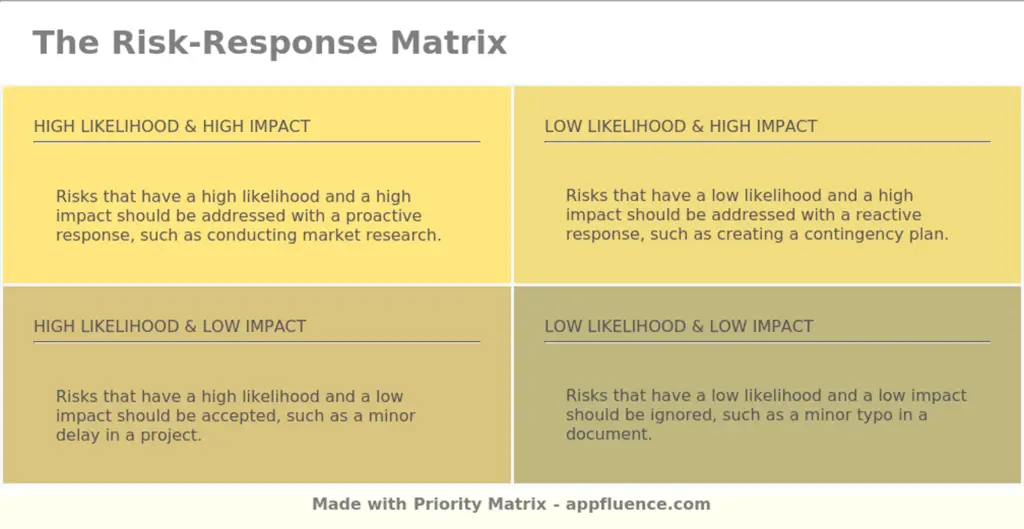What is the Risk-Response Matrix?
The Risk-Response Matrix is a 2×2 matrix used to evaluate and manage risks in a business. It is used to identify and prioritize risks based on their likelihood and potential impact. The matrix helps businesses identify which risks should be addressed first and which risks can be accepted or ignored.
How Does the Risk-Response Matrix Work?
The Risk-Response Matrix is divided into four quadrants, each representing a different risk-response strategy. The top-left quadrant is for risks that have a high likelihood and a high impact, and should be addressed with a proactive response. The top-right quadrant is for risks that have a low likelihood and a high impact, and should be addressed with a reactive response. The bottom-left quadrant is for risks that have a high likelihood and a low impact, and should be accepted. The bottom-right quadrant is for risks that have a low likelihood and a low impact, and should be ignored.
For example, a business might identify a risk that a new product launch will fail due to a lack of customer interest. This risk would be placed in the top-left quadrant, as it has a high likelihood and a high impact. The business should then take a proactive response to this risk, such as conducting market research to better understand customer needs.
Benefits of the Risk-Response Matrix
The Risk-Response Matrix provides a simple yet effective way for businesses to identify, prioritize, and manage risks. By evaluating risks based on their likelihood and potential impact, businesses can quickly determine which risks should be addressed first and which risks can be accepted or ignored. This helps businesses focus their resources on the risks that are most likely to have the greatest impact.
The Risk-Response Matrix also helps businesses develop a proactive approach to risk management. By identifying risks early and taking proactive steps to address them, businesses can reduce the likelihood of negative outcomes and minimize the potential impact of risks.
Using Priority Matrix to Work with the Risk-Response Matrix
Priority Matrix is a powerful tool for working with the Risk-Response Matrix. With Priority Matrix, businesses can easily create and manage risk-response matrices, identify and prioritize risks, and develop strategies to address those risks.
Priority Matrix also provides a range of features to help businesses manage their risk-response matrices. For example, businesses can use Priority Matrix to track the progress of their risk-response strategies, assign tasks to team members, and collaborate with stakeholders. This makes it easier for businesses to stay on top of their risk-response strategies and ensure that risks are addressed in a timely and effective manner.
In addition, Priority Matrix provides a range of reporting and analytics features that can be used to track the performance of risk-response strategies. This helps businesses identify areas for improvement and ensure that their risk-response strategies are delivering the desired results.
Conclusion
The Risk-Response Matrix is a powerful tool for evaluating and managing risks in a business. By identifying and prioritizing risks based on their likelihood and potential impact, businesses can quickly determine which risks should be addressed first and which risks can be accepted or ignored. Priority Matrix is a powerful tool for working with the Risk-Response Matrix, providing a range of features to help businesses manage their risk-response matrices, track the progress of their risk-response strategies, and measure the performance of their risk-response strategies.
If you would like to try the Risk-Response Matrix template in Priority Matrix, click along and import it into the app. You can get a free account in one click. And if you have ideas for us to cover other template formats, please send us a message using the link above.

